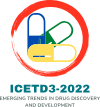Speaker
Description
The present work is aimed to investigate the effect of ethanolic extract of fruit pulp of Annona squamosa against aluminium chloride-induced Alzheimer’s disease. Male Wistar rats were selected in this study and were divided into five groups (6 each). Group, I served as standard control. Group II received aluminium chloride (17 mg/kg, P.O.). Group III received rivastigmine (0.3 mg/kg, I.P.) and inducing agent (AlCl$_{3}$ 17 mg/kg, P.O.). Group IV and V received an ethanolic extract of Annona squamosa (200 mg/kg, 400 mg/kg, P.O. respectively) and inducing agent (AlCl$_{3}$ 17 mg/kg, P.O.). The rats were given respective treatment for 90 days, and behavioral parameters were determined on the 90th day. After the 90th-day rats were sacrificed, biochemical and histopathological parameters were determined. Oral administration of ethanolic extract of Annona squamosa fruit pulp at doses 200, 400 mg/kg body weight showed improvement in behavioral parameters when compared to AlCl$_{3}$ induced rats, showed an increase in superoxide dismutase, catalase, reduced glutathione, and decreased levels of malondialdehyde and showed a decrease in brain acetylcholinesterase content when compared to AlCl$_{3}$ induced rats. The reported saturated fatty acids such as oleic acid, linoleic acids are found in animals and plants. They are primarily used to produce hormone-like substances that regulate various functions, including blood pressure, blood clotting, blood lipid levels, immune response, and the inflammation response to injury infection. The study demonstrated the beneficial effects of fruit pulp of Annona squamosa by improving biochemical and behavioral parameters.
Bibliography:
-
Krasovskiĭ GN, Vasukovich LY, Chariev OG. (1979) Experimental study of biological effects of leads and aluminium following oral administration. Environ Health Perspect. 30: 47-51. DOI: https://doi.org/10.1289/ehp.30-1637724
-
Mahdy K, Shaker O, Wafay H, Nassar Y, Hassan H, Hussein A. (2012) Effect of some medicinal plant extracts on the oxidative stress status in Alzheimer’s disease induced in rats. Eur Rev Med Pharmacol Sci 16 (3): 31-42.
-
Baskaran R, Pullencheri D, Somasundaram R. (2016) Characterization of free, esterified and bound phenolics in custard apple Annona squamosa L fruit pulp by UPLC –ESI-MS/MS. Food Res Int 82: 121-127. DOI: https://doi.org/10.1016/j.foodres.2016.02.001
-
Meechaona R, Sengpracha W, Banditpuritat J, Kawaree R, Phutdhawong W. (2007) Fatty acid content and antioxidant activity of Thai bananas. Maejo Int J Sci Technol 01(02): 222-228.
-
Chavali VD, Agarwal M, Vyas VK, Saxena B. (2020) Neuroprotective effects of ethyl pyruvate against aluminum chloride-induced Alzheimer’s disease in rats via inhibiting Toll-like receptor 4. J Mol Neurosci 70(6): 836-850. DOI: https://doi.org/10.1007/s12031-020-01489-9
